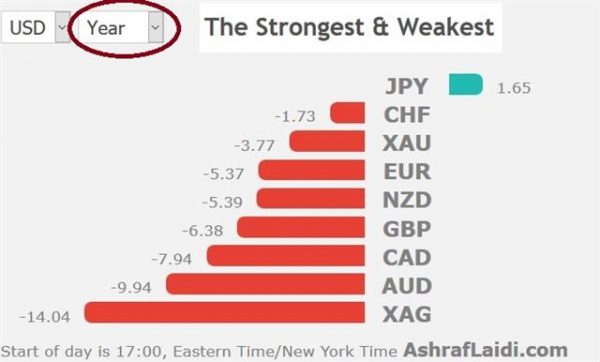If the major US indices drop another 6% will, they will get us to the 200-week moving average, i.e. 2348 on SPX, 20687 on DOW30, or -20% from the top. It appears as though the next stop in S&P500 and DOW30 is 20670 Even on Christmas Eve when US markets are meant to close early, equity markets continue to wilt and risk trades soure, while talk of Trump firing Fed chair Powell didn’t help. Neither did the “do not panic” letter sent by US Treasury secretary Mnuchin to the nation’s top banks helped as US indices fall 14% in December, the biggest monthly decline since the fateful October 2008. US indices are also posting their 10th consecutive losing day, a streak never seen this millenium according to Ashraf. CFTC positioning data showed fresh GBP selling and EUR stabilisation. The Premium short in USDJPY hit its final target for 200-pip gain. The last two trades in the DOW were stopped out.
From the sunny market days of September, oil and some equity markets have fallen into a bear market in short order. Last week was the worst for US equity indexes since 2011 as the S&P 500 fell 7%. Month-to-date, S&P500 & DOW30 are down 14%.
The worries are familiar, primarily tariffs, interest rates and Chinese growth. At the same time, there are plenty of indications that the US economy is strong and few signs of a sharp slowdown, let alone a recession. One exception is business investment, something we highlighted last week. Core durable goods orders fell 0.6% in the November report and that marks a contraction in three of the past four months.
At the same time, the calendar provides some clues. The rout in the past week had the distinct flavor of a market being driven by forced selling, flows and fears. Year-end tax loss selling is undoubtedly part of the equation and hedge fund underperformance may have finally triggered waves of redemptions.
Perhaps the selling isn’t justified but consider this: Sometimes that market can create its own narrative. Selling can stifle the mood in the economy; banks slow lending and consumers tighten up. It can become a self-fulfilling prophesy. The turmoil can also lead politicians to make some grave errors. The White House was in damage control on the weekend after reports said Trump had frequently mulled firing Fed Chair Powell in the past week.
Ironically, the biggest problem for the markets may well be the various positives of the US economy, which currently act as an excuse for the Fed to commit its obligatory cyclical policy mistake.
CFTC Commitments of Traders
Speculative net futures trader positions as of the close on Tuesday. Net short denoted by – long by +. This week’s report was delayed because of the US holiday.
EUR -53K vs -56K prior GBP -61K vs -42K prior JPY -103K vs -98K prior CHF -23K vs -18K prior CAD -7K vs -12K prior AUD -35K vs -46K prior NZD -3K vs -15K prior
Specs picked a bad week to lighten up on AUD and NZD shorts as both paid of late in the week as risk aversion escalated. Meanwhile cable slumped on Dec 9-10 but rebounded afterwards and has chopped sideways. Still, it’s never more than one Brexit headline away from another rout.














